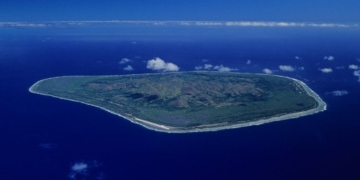Pha Ké (meaning “mountain” in Thai) is located opposite Quan Hóa Town, across the Mã River within the territory of Hồi Xuân Commune. The rocky mountain near the banks of the Mã River has steep cliffs. It is here, midway up the cliff, that a series of small rock niches containing ancient coffins have been discovered.
In five of these rock niches, locals have uncovered dozens of ancient coffins. In one niche, approximately 100 meters above the river’s surface, a large coffin was found. Before it was destroyed, this coffin still contained a skull resting on a sword. Currently, the sword has been taken, and the skull has been discarded into the river.
In the second rock niche (about 100 meters from the first), located around 60 meters above the river, locals also discovered two sets of coffins placed on the stone floor. One was 2.68 meters long and nearly half a meter in diameter, hollowed out like a boat. These coffins have also been broken apart, leaving only a few bone fragments and shards of prehistoric pottery.
In the third rock niche, locals found two sets of coffins placed on a wooden rack. However, these too have been damaged, with only a piece of a saw blade made of sandstone and some pottery shards remaining. The remaining two niches each contained two sets of coffins. The wood used for these coffins has decayed, and no artifacts remain.
Further away, about 4 kilometers from Quan Hóa Town, along the Luồng River (in Hồi Xuân Commune), locals have also discovered two other caves containing dozens of ancient coffins. These caves are located on steep rock cliffs about 150 meters above the river and are very difficult to access. However, all the ancient coffins in these two caves have also been destroyed, and the accompanying burial goods have disappeared.
Thus, in the area around Quan Hóa Town, there are nearly ten large and small caves containing hundreds of ancient coffins. This indicates that the land of Quan Hóa is preserving an ancient culture that remains dormant…
What is the connection to the burial caves in China?
Quan Hóa is geographically unique, located in a transitional area from the upper to middle reaches of the Mã River, where many rivers and streams converge. In addition to the Luồng River, the Lò River and several large streams join here. Because it is situated in an area with many rivers, Quan Hóa can be regarded as a waterway junction, an important location for communication between Northwest Vietnam, Central Laos, and Thanh Hóa. This may partially explain the allure of an area that has concentrated ancient populations and many cultural layers from different historical periods, including the practice of burial in caves on high cliffs.
Dr. Nguyễn Gia Đối from the Archaeological Institute notes that this is the first time archaeologists have encountered such a high concentration of burial practices in niches and caves on steep cliffs, as seen in Quan Hóa. In Southeast Asia, this type of burial has only been found in Thailand and the Philippines. In China, however, this practice is more commonly found, especially in the southern regions.
In China, each region has different names for this burial practice, with the most common being “hanging coffin” (悬棺葬), “cliff cave burial” (崖洞葬), or “rock face burial” (崖葬). In China, there are also burial methods that involve placing coffins directly on the stone floor and elevating them on wooden platforms. However, the latter is specifically referred to as hanging coffin burial.
Regarding dating, ancient coffins in China span various historical periods, from the Warring States to the Ming and Qing dynasties. Ethnically, they belong to the Baiyue people residing in the southeastern regions south of the Yangtze River. This practice gradually spread to the southwest, where the Ba Bộc people lived.
However, since this form of burial has been discovered in Vietnam for the first time with such a high concentration, scientists lack precedents for comparison regarding dating and ethnicity. Dr. Nguyễn Gia Đối and his colleagues hypothesize that these sites contain early graves dating back a few centuries AD, preceding those from the 8th to 9th centuries, with certain representations being bronze and ceramic artifacts.
Regardless of the inhabitants’ identity, the cultural style is still reflected in the burial goods. The artifacts discovered in the burial caves of Quan Hóa closely resemble those from the Đông Sơn culture and the later cultures of the Northern Delta. Clearly, the land of Quan Hóa possesses unique and rare archaeological relics in Vietnam.


















































